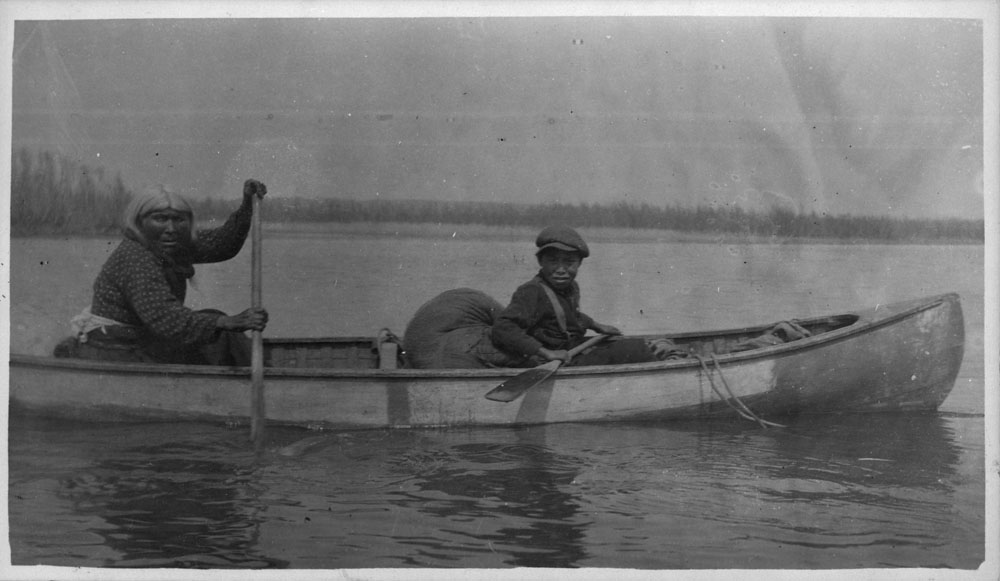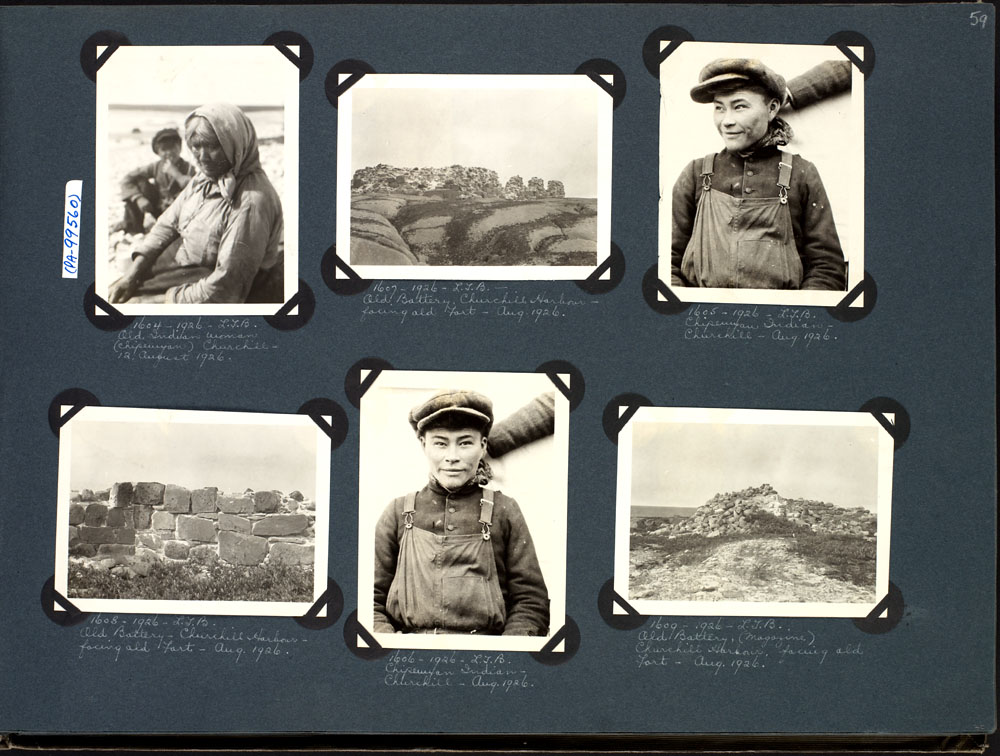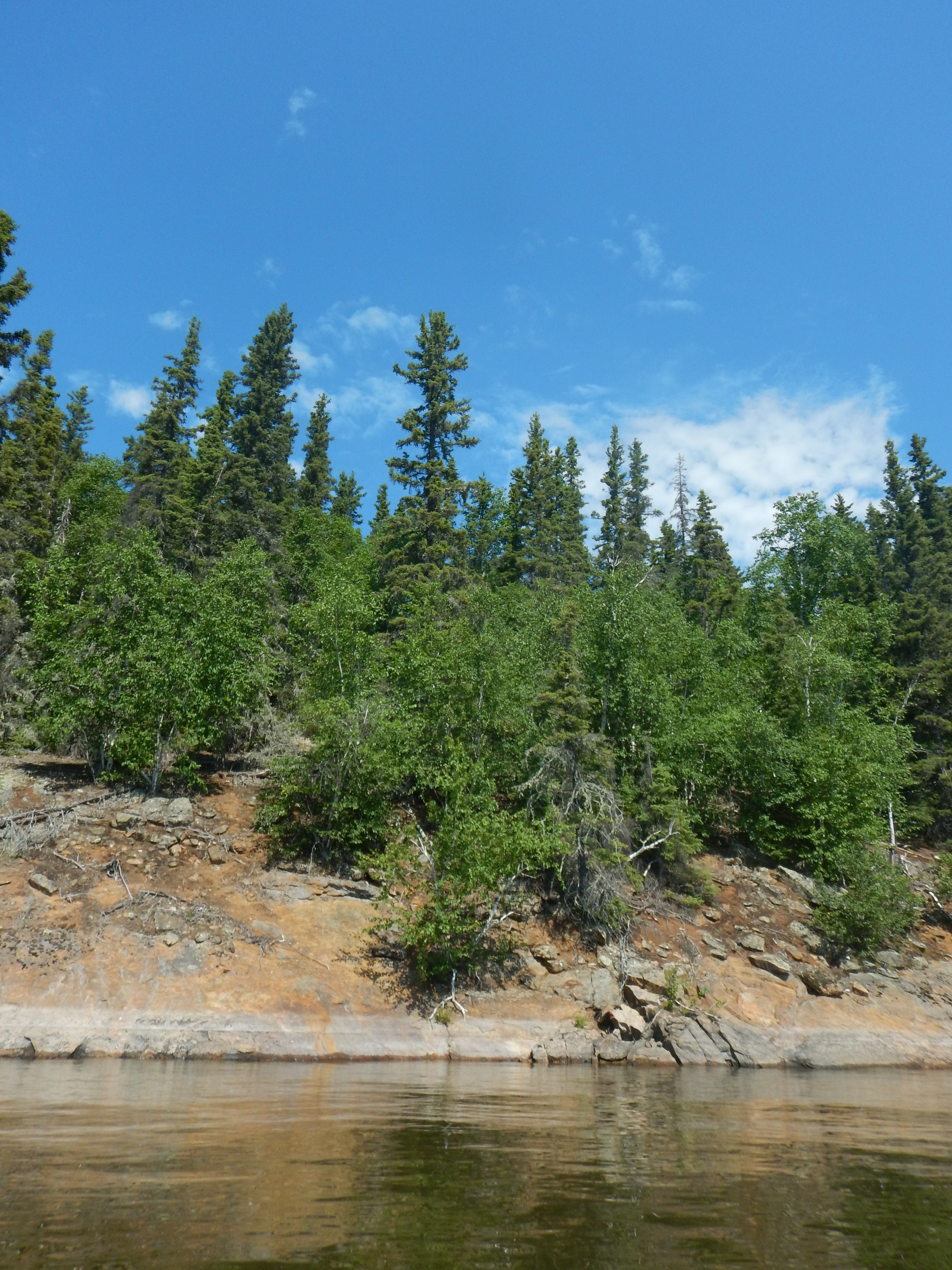|
Northlands Dene First Nation
The Northlands Denesuline First Nation ( chp, ᓂ ᗂᘚ ᑌᓀ, Nįh hots’į Dene) is a First Nations in Canada, First Nations band government in northwestern Manitoba, Canada. This Dene or Denesuline population were part of a larger group once called the "Caribou-eaters". The community of Lac Brochet, Manitoba, Lac Brochet or Dahlu T’ua( chp, ᑕᐤᕊ ᕤᐧᐁ, Dahlu T’ua) ('Jackfish Lake') is the administrative centre of the Northlands First Nation. Seven-hundred-twenty residents of Lac Brochet chose Dene as their mother tongue in 2011. English was spoken by most of the population. Territory The territories of the First Nation include five parcels of land: *Lac Brochet 197A — with , contains the community of Lac Brochet, Manitoba, Lac Brochet *Sheth Chok — with *Thuycholeeni — with *Thuycholeeni Aze — with *Tthekale Nu — with Membership As of February 2013 the total membership of Northland First Nation was 1,024 with 868 members living on-reserve and 1 ... [...More Info...] [...Related Items...] OR: [Wikipedia] [Google] [Baidu] |
Dene
The Dene people () are an indigenous group of First Nations who inhabit the northern boreal and Arctic regions of Canada. The Dene speak Northern Athabaskan languages. ''Dene'' is the common Athabaskan word for "people". The term "Dene" has two usages. More commonly, it is used narrowly to refer to the Athabaskan speakers of the Northwest Territories and Nunavut in Canada, especially including the Chipewyan (Denesuline), Tlicho (''Dogrib''), Yellowknives (T'atsaot'ine), Slavey (Deh Gah Got'ine or Deh Cho), and Sahtu (the Eastern group in Jeff Leer's classification; part of the Northwestern Canada group in Keren Rice's classification). However, it is sometimes also used to refer to all Northern Athabaskan speakers, who are spread in a wide range all across Alaska and northern Canada. The Southern Athabaskan speakers, however, also refer to themselves by similar words: Diné (Navajo) and Indé (Apache). Location Dene are spread through a wide region. They live in the ... [...More Info...] [...Related Items...] OR: [Wikipedia] [Google] [Baidu] |
Denesuline
The Chipewyan ( , also called ''Denésoliné'' or ''Dënesųłı̨né'' or ''Dënë Sųłınë́'', meaning "the original/real people") are a Dene Indigenous Canadian people of the Athabaskan language family, whose ancestors are identified with the Taltheilei Shale archaeological tradition. They are part of the Northern Athabascan group of peoples, and come from what is now Western Canada. Terminology The term ''Chipewyan'' (ᒌᐘᔮᐣ) is a Cree exonym meaning ''pointed hides'', referring to the design of their parkas. The French-speaking missionaries to the northwest of the Red River Colony referred to the Chipewyan people as Montagnais in their documents written in French. Montagnais simply means "mountain people" or "highlanders" in French and has been applied to many unrelated nations across North America over time. For example the Neenolino Innu of northern Quebec are also called "Montagnais". Demographics Chipewyan peoples live in the region spanning the we ... [...More Info...] [...Related Items...] OR: [Wikipedia] [Google] [Baidu] |
Lac Brochet, Manitoba
Lac Brochet 197A ( chp, ᑕᐤᕊ ᕤᐧᐁ, Dahlu T’ua) is a Dene Indian reserve of the Northlands Denesuline First Nation, located in the boreal forest of northern Manitoba, Canada. It is situated on the north shore of Lac Brochet, located northwest of the city of Thompson. The reserve contains the unincorporated community of Lac Brochet (), which is the administrative centre of the Northlands Denesuline First Nation. There are no permanent roads connecting Lac Brochet with other parts of Manitoba (there are some that are passable only during the winter). Many residents travel using the Lac Brochet Airport located near town. Petit Casimir Memorial School is the K-12 school in the community. Northlands Denesuline First Nation The Lac Brochet community is the administrative centre of the Northlands Denesuline First Nation. As of September 2021, the total membership of Northland Denesuline First Nation was 1,153 with 975 members living on-reserve and 173 members living ... [...More Info...] [...Related Items...] OR: [Wikipedia] [Google] [Baidu] |
Keewatin Tribal Council
Keewatin Tribal Council is a tribal council representing 11 First Nation band governments in the province of Manitoba. Its head offices are located in Thompson, Manitoba, with a secondary office in Winnipeg. Members The Keewatin Tribal Council represents the following First Nation band governments (registered populations as of August 2013): * Barren Lands First Nation — offices in Brochet, Manitoba; registered population was 1,088. *Bunibonibee Cree Nation — offices in Oxford House, Manitoba; registered population was 2,892. * Fox Lake Cree Nation — offices in Gillam, Manitoba; registered population was 1,165. *God's Lake First Nation — offices in Gods Lake Narrows, Manitoba; registered population was 2,603. * Manto Sipi Cree Nation — offices in Gods River, Manitoba; registered population was 646. * Northlands Dene First Nation — offices in Lac Brochet, Manitoba; registered population was 1,035. * Sayisi Dene First Nation — offices in Tadoule Lake, Manitoba; ... [...More Info...] [...Related Items...] OR: [Wikipedia] [Google] [Baidu] |
First Nations In Canada
First Nations (french: Premières Nations) is a term used to identify those Indigenous Canadian peoples who are neither Inuit nor Métis. Traditionally, First Nations in Canada were peoples who lived south of the tree line, and mainly south of the Arctic Circle. There are 634 recognized First Nations governments or bands across Canada. Roughly half are located in the provinces of Ontario and British Columbia. Under Charter jurisprudence, First Nations are a "designated group," along with women, visible minorities, and people with physical or mental disabilities. First Nations are not defined as a visible minority by the criteria of Statistics Canada. North American indigenous peoples have cultures spanning thousands of years. Some of their oral traditions accurately describe historical events, such as the Cascadia earthquake of 1700 and the 18th-century Tseax Cone eruption. Written records began with the arrival of European explorers and colonists during the Age of D ... [...More Info...] [...Related Items...] OR: [Wikipedia] [Google] [Baidu] |
Band Government
In Canada, an Indian band or band (french: bande indienne, link=no), sometimes referred to as a First Nation band (french: bande de la Première Nation, link=no) or simply a First Nation, is the basic unit of government for those peoples subject to the '' Indian Act'' (i.e. status Indians or First Nations). Bands are typically small groups of people: the largest in the country, the Six Nations of the Grand River First Nation had 22,294 members in September 2005, and many have a membership below 100 people. Each First Nation is typically represented by a band council (french: conseil de bande) chaired by an elected chief, and sometimes also a hereditary chief. As of 2013, there were 614 bands in Canada. Membership in a band is controlled in one of two ways: for most bands, membership is obtained by becoming listed on the Indian Register maintained by the government. As of 2013, there were 253 First Nations which had their own membership criteria, so that not all status Indians ... [...More Info...] [...Related Items...] OR: [Wikipedia] [Google] [Baidu] |
Manitoba
, image_map = Manitoba in Canada 2.svg , map_alt = Map showing Manitoba's location in the centre of Southern Canada , Label_map = yes , coordinates = , capital = Winnipeg , largest_city = Winnipeg , largest_metro = Winnipeg Region , official_lang = English , government_type = Parliamentary constitutional monarchy , Viceroy = Anita Neville , ViceroyType = Lieutenant Governor , Premier = Heather Stefanson , Legislature = Legislative Assembly of Manitoba , area_rank = 8th , area_total_km2 = 649950 , area_land_km2 = 548360 , area_water_km2 = 101593 , PercentWater = 15.6 , population_demonym = Manitoban , population_rank = 5th , population_total = 1342153 , population_as_of = 2021 , population_est = 142022 ... [...More Info...] [...Related Items...] OR: [Wikipedia] [Google] [Baidu] |
Tribal Chief
A tribal chief or chieftain is the leader of a tribal society or chiefdom. Tribe The concept of tribe is a broadly applied concept, based on tribal concepts of societies of western Afroeurasia. Tribal societies are sometimes categorized as an intermediate stage between the band society of the Paleolithic stage and civilization with centralized, super-regional government based in cities. Anthropologist Elman Service distinguishes two stages of tribal societies: simple societies organized by limited instances of social rank and prestige, and more stratified societies led by chieftains or tribal kings ( chiefdoms). Stratified tribal societies led by tribal kings are thought to have flourished from the Neolithic stage into the Iron Age, albeit in competition with urban civilisations and empires beginning in the Bronze Age. In the case of tribal societies of indigenous peoples existing within larger colonial and post-colonial states, tribal chiefs may represent their tribe or ... [...More Info...] [...Related Items...] OR: [Wikipedia] [Google] [Baidu] |
Thompson, Manitoba
Thompson (population 13,678) is the largest city in the Northern Region of Manitoba and is situated along the Burntwood River, north of Winnipeg. Originally founded in 1956 as a mining town, it now primarily serves as the "Hub of the North", providing goods and services such as healthcare and retail trade to the surrounding communities. Thompson's trade area is larger than New Mexico, yet it has fewer than 15,000 residents, with many of the smaller communities accessible only by air or winter road. Despite its isolated location in the heart of Canada's boreal forest, it is connected to Winnipeg via paved highway, railway ( Via Rail), and Thompson Airport. It also has modern amenities, such as fibre optic internet and a large retail scene, including half a dozen shopping malls and several large chain stores (e.g., Walmart, Giant Tiger, Safeway, Shoppers Drug Mart and Canadian Tire). Thompson's natural and undisturbed surroundings make it popular with outdoor enthusiasts ... [...More Info...] [...Related Items...] OR: [Wikipedia] [Google] [Baidu] |
Denesuline Language
Chipewyan or Denesuline (ethnonym: ), often simply called Dene, is the language spoken by the Chipewyan people of northwestern Canada. It is categorized as part of the Northern Athabaskan language family. Dënësųłinë́ has nearly 12,000 speakers in Canada, mostly in Saskatchewan, Alberta, Manitoba and the Northwest Territories.Statistics Canada: 2006 Census Sum of 'Chipewyan' and 'Dene'. It has official status only in the Northwest Territories, alongside 8 other [...More Info...] [...Related Items...] OR: [Wikipedia] [Google] [Baidu] |
First Nations Governments In Manitoba
First or 1st is the ordinal form of the number one (#1). First or 1st may also refer to: *World record, specifically the first instance of a particular achievement Arts and media Music * 1$T, American rapper, singer-songwriter, DJ, and record producer Albums * ''1st'' (album), a 1983 album by Streets * ''1st'' (Rasmus EP), a 1995 EP by The Rasmus, frequently identified as a single * ''1ST'', a 2021 album by SixTones * ''First'' (Baroness EP), an EP by Baroness * ''First'' (Ferlyn G EP), an EP by Ferlyn G * ''First'' (David Gates album), an album by David Gates * ''First'' (O'Bryan album), an album by O'Bryan * ''First'' (Raymond Lam album), an album by Raymond Lam * ''First'', an album by Denise Ho Songs * "First" (Cold War Kids song), a song by Cold War Kids * "First" (Lindsay Lohan song), a song by Lindsay Lohan * "First", a song by Everglow from '' Last Melody'' * "First", a song by Lauren Daigle * "First", a song by Niki & Gabi * "First", a song by Jonas Brot ... [...More Info...] [...Related Items...] OR: [Wikipedia] [Google] [Baidu] |
Dene Governments
The Dene people () are an indigenous group of First Nations who inhabit the northern boreal and Arctic regions of Canada. The Dene speak Northern Athabaskan languages. ''Dene'' is the common Athabaskan word for "people". The term "Dene" has two usages. More commonly, it is used narrowly to refer to the Athabaskan speakers of the Northwest Territories and Nunavut in Canada, especially including the Chipewyan (Denesuline), Tlicho (''Dogrib''), Yellowknives (T'atsaot'ine), Slavey (Deh Gah Got'ine or Deh Cho), and Sahtu (the Eastern group in Jeff Leer's classification; part of the Northwestern Canada group in Keren Rice's classification). However, it is sometimes also used to refer to all Northern Athabaskan speakers, who are spread in a wide range all across Alaska and northern Canada. The Southern Athabaskan speakers, however, also refer to themselves by similar words: Diné (Navajo) and Indé (Apache). Location Dene are spread through a wide region. They live in the Macke ... [...More Info...] [...Related Items...] OR: [Wikipedia] [Google] [Baidu] |





